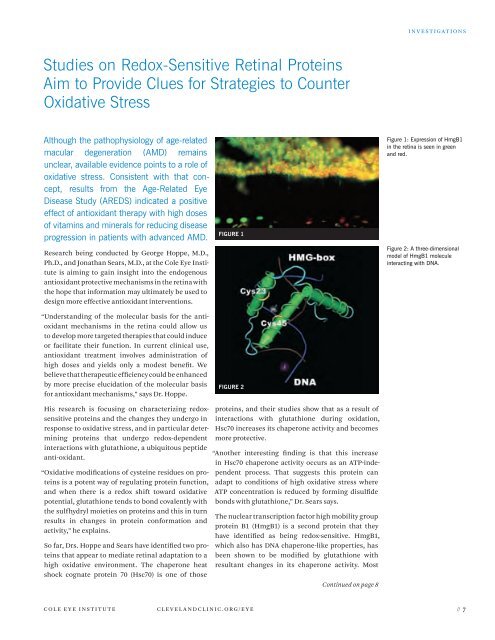Ophthalmology Update - Cleveland Clinic
Ophthalmology Update - Cleveland Clinic
Ophthalmology Update - Cleveland Clinic
You also want an ePaper? Increase the reach of your titles
YUMPU automatically turns print PDFs into web optimized ePapers that Google loves.
Studies on Redox-Sensitive Retinal Proteins<br />
Aim to Provide Clues for Strategies to Counter<br />
Oxidative Stress<br />
Although the pathophysiology of age-related<br />
macular degeneration (AMD) remains<br />
unclear, available evidence points to a role of<br />
oxidative stress. Consistent with that concept,<br />
results from the Age-Related Eye<br />
Disease Study (AREDS) indicated a positive<br />
effect of antioxidant therapy with high doses<br />
of vitamins and minerals for reducing disease<br />
progression in patients with advanced AMD.<br />
research being conducted by george hoppe, m.d.,<br />
ph.d., and Jonathan sears, m.d., at the cole eye institute<br />
is aiming to gain insight into the endogenous<br />
antioxidant protective mechanisms in the retina with<br />
the hope that information may ultimately be used to<br />
design more effective antioxidant interventions.<br />
“Understanding of the molecular basis for the antioxidant<br />
mechanisms in the retina could allow us<br />
to develop more targeted therapies that could induce<br />
or facilitate their function. in current clinical use,<br />
antioxidant treatment involves administration of<br />
high doses and yields only a modest benefit. We<br />
believe that therapeutic efficiency could be enhanced<br />
by more precise elucidation of the molecular basis<br />
for antioxidant mechanisms,” says dr. hoppe.<br />
his research is focusing on characterizing redoxsensitive<br />
proteins and the changes they undergo in<br />
response to oxidative stress, and in particular determining<br />
proteins that undergo redox-dependent<br />
interactions with glutathione, a ubiquitous peptide<br />
anti-oxidant.<br />
“Oxidative modifications of cysteine residues on proteins<br />
is a potent way of regulating protein function,<br />
and when there is a redox shift toward oxidative<br />
potential, glutathione tends to bond covalently with<br />
the sulfhydryl moieties on proteins and this in turn<br />
results in changes in protein conformation and<br />
activity,” he explains.<br />
so far, drs. hoppe and sears have identified two proteins<br />
that appear to mediate retinal adaptation to a<br />
high oxidative environment. the chaperone heat<br />
shock cognate protein 70 (hsc70) is one of those<br />
FIGURE 1<br />
FIGURE 2<br />
proteins, and their studies show that as a result of<br />
interactions with glutathione during oxidation,<br />
hsc70 increases its chaperone activity and becomes<br />
more protective.<br />
“another interesting finding is that this increase<br />
in hsc70 chaperone activity occurs as an atp-independent<br />
process. that suggests this protein can<br />
adapt to conditions of high oxidative stress where<br />
atp concentration is reduced by forming disulfide<br />
bonds with glutathione,” dr. sears says.<br />
the nuclear transcription factor high mobility group<br />
protein B1 (hmgB1) is a second protein that they<br />
have identified as being redox-sensitive. hmgB1,<br />
which also has dna chaperone-like properties, has<br />
been shown to be modified by glutathione with<br />
resultant changes in its chaperone activity. most<br />
Continued on page 8<br />
i n v e s t i g a t i O n s<br />
Figure 1: Expression of HmgB1<br />
in the retina is seen in green<br />
and red.<br />
Figure 2: A three-dimensional<br />
model of HmgB1 molecule<br />
interacting with DNA.<br />
c O l e e y e i n s t i t U t e c l e v e l a n d c l i n i c . O r g / e y e //
















